We’ve all seen the golf pros on TV taking divots but is it something we should all be doing? And if so, which clubs should we be doing it with? In this article we brush over everything to do with divots.

In general, pro golfers take a divot because it ensures better contact with the golf ball. The key is not actually the divot itself, but the downward strike which just so happens to create a divot, after the ball.

Unlike many people believe, pro golfers rarely play a perfect shot. There are too many things that have to work for a perfect shot to be played.
Instead of chasing the perfect shot, they are looking for as much margin for error as possible. Improving their margin for error allows their bad shots to become better.
Pro golfers build their games on consistency. And that means eliminating those disasterous shots.
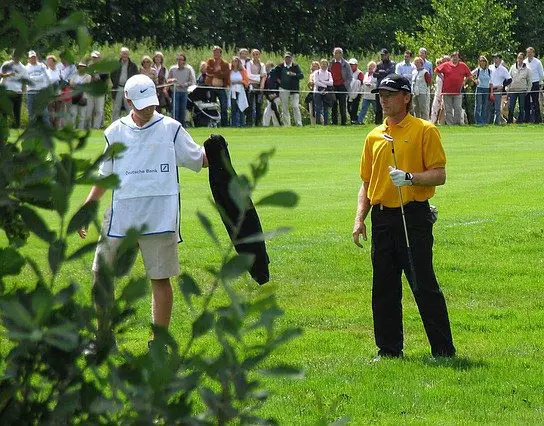
Generally speaking, picking the ball off the turf cleanly requires more precision. For most golfers, this leads to inconsistency in strike.
By taking a thin divot after the ball, pro golfers ensure a good strike with the ball. That doesn’t mean they hit every shot perfect, but they hit every shot very close to the correct distance. This means they can find the green much more often and take hazards such as water out of play.
They key to how pro golfers take divots is how their club approaches the ball at impact. Rather than trying to pick the ball cleanly off the turf, they allow the club slightly downwards at impact. The objective is to take a divot after the ball.
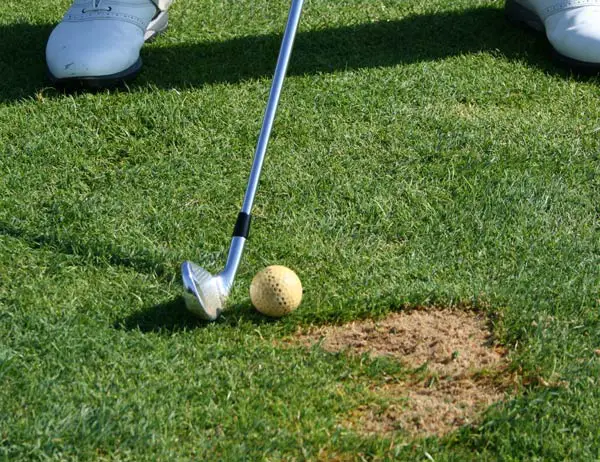
By taking a divot after impact, pro golfers ensure that the divot does not affect the contact with the ball. If the divot is made before impact, a poor shot is generally the result.
One of the keys to how professional golfers make a good divot is by having a shallow angle of attack. This produces a shallow divot, the perfect kind of divot.

A shallow angle of attack is where the club is travelling very close to the ground at impact. This is in contrast to a steep angle of attack where the club would be coming towards impact from a position high above the ground.
This shallow attack provides pro golfers with much more room for error. It is generally achieved by keeping the hands ahead of the ball at impact. This is also known as “forward shaft lean”.
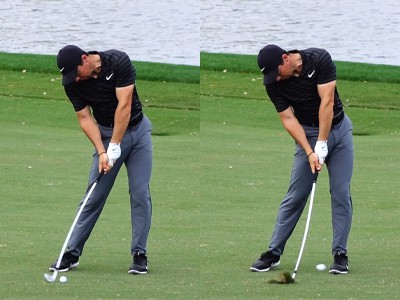
Forward shaft lean makes a wristy shot less likely and promotes consistency. Simply put, it allows for better ball striking. You will struggle to find a single pro golfer that doesn’t hit the ball with forward shaft lean.
The only problem with a shallow angle of attack is that it becomes easy to make contact with the ground early, since the club is travelling so low to it.
This is where the divot comes in.
Pro golfers use a shallow angle of attack in combination with a downward strike, or downward angle of attack. All this means is that the clubhead is moving downwards (towards the ground) as they make contact with the golf ball.
By hitting slightly downward through impact, pro golfers ensure they make contact with the ball first, before the ground. This is why you see pro golfers take a divot practically every time the ball is on the ground.
They still have to time the strike, to ensure the divot comes just after the ball. But now they have more room for error:
This is in contrast to the player that picks the ball with no divot. They have to be just about perfect with their timing or they will hit a fat or thin shot.
Note: If the golf ball is teed up, the strike point is raised above the ground so a divot becomes less likely. A downward angle of attack from the tee may not even touch the turf at all.
For most golfers, almost every golf club in the bag takes a divot. The exception to this is the driver, fairway wood, or any time the ball is teed up. But other than the driver, you can still take a divot with any other club, even from a tee.

So now let’s get onto which clubs you should take a divot with. But bear in mind that it comes down to the individual in the end and what works for them. The following are only recommendations.
In general, you should take a divot with practically every iron shot. This is because the ball is played from the ground. Taking a divot improves your margin for error, making a good strike much more likely.

Irons are also designed to take a divot. If you are not taking a divot with them, you are not using them as intended. Almost every golfer hits better iron shots when they take a divot.
There are some exceptions where you don’t need to take a divot with your irons. The obvious case is when the ball is teed up. Since the ball is not on the ground, you don’t need to take a divot to ensure a good strike.
However, the vast majority of pro golfers still take a divot with an iron from the tee. The main reason is consistency. If you do not take a divot, you are changing the way you hit the shot. This can change the flight of the ball and how far it travels, making distance control much more difficult.

Additionally, irons are designed to be hit from the ground with a divot. Hitting from a high tee can result in strikes that are too high on the face, leading to a weak shot.
Most pro golfers tee the ball very low with an iron. So low that you almost can’t tell they’re using a tee. This gives them a perfect lie but they can play the shot in exactly the same way as if it were on the ground.
In general, you should still take a small divot with a long iron. Playing it just like any other iron gives you the best chance of striking the ball cleanly.
However, a divot with a long iron will generally be smaller, because the club is longer with a more shallow lie angle. This means that you stand further form the ball, which makes your swing flatter. A flatter swing leads to a more shallow strike, and therefore a smaller divot.

But most pros still take a divot with their long irons or at least bruise the grass in front of their ball. Don’t be tempted to try to lift the ball in the air. Commit to the shot like a normal iron and don’t be afraid to take a divot.
With a wedge shot you should almost always take a divot. In general, a divot with a wedge will be slightly deeper than with other clubs.
This is because the club is shorter and has a more upright lie angle. Because you stand closer to the ball, the swing becomes more upright. This results in a steeper swing which causes a bigger divot.

But try to make sure that your divots aren’t really big or you will struggle with consistency. You should still be aiming for a shallow divot after the ball.
Typically, a small divot is also preferable on pitch shots. A pitch shot can be thought of as a shorter version of your normal swing. There is no reason to massively change your swing for a pitch.
Whether you take a divot when chipping or not will depend on the type of chip you are playing. If you are playing a low chip then taking a divot is fine.
Tiger Woods and Phil Mickelson often take a divot when playing a low spinning chip. They move the ball further back in the stance with the hands ahead, and make a slightly downward strike that causes a small divot. This is a great shot to play from a tight lie or where there is plenty of green to work with.
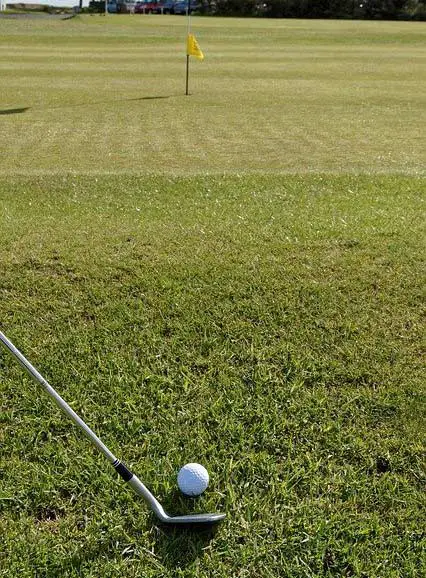
However, they generally don’t take a divot when playing a higher chip or a flop shot. In this case, they allow the club to release, sliding it under the ball. If the sole of the club is used properly, this can also be effective from tight lies.
Feel free to practice your chipping and experiment with this. Try hitting low spinners with a little divot and try playing some high floaters where you just brush the grass. The high ones are easier when the ball is sat up a little in some taller grass.
With a fairway wood, you generally aren’t required to take a divot. The club is designed to glide along the turf more easily, making a sweeping strike much more forgiving.
However, you may find that taking a small divot helps you to strike the ball better. This is especially true when playing from the fairway or a tight lie. Many pros take a divot with their fairway woods or bruise the grass in front of the ball.
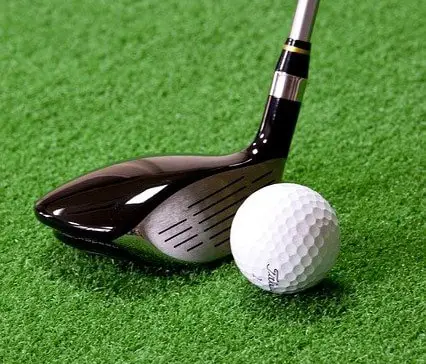
Be aware that since the club is long and flat, you shouldn’t be taking a big divot. But you may find that taking a small divot after the ball helps you to find a good strike on the ball more often.
Just do whatever works for you. If you find that sweeping the ball off the turf works better that’s fine. If you find that taking a small divot helps, then that’s also fine.
A divot in not necessarily required with a hybrid club but most golfers tend to find it helps.
Hybrids sit somewhere between a long iron and a fairway wood. Many players use them instead of long irons. It may be best for you to think of them as a long iron and use them in the same way.

From the fairway or a tight lie, a small divot will generally help you to get a clean strike. But since they have a larger and more rounded sole like a wood, they are capable of gliding along the turf well.
This makes them ideal for players that don’t like taking a divot with longer clubs, or if the ball is in the rough. This is why they’re sometimes called rescue clubs.
If possible, a grass driving range is ideal for practicing taking a divot. Or a patch of short grass that you can dig up (probably not the front lawn!). You can practice taking a divot on driving range mats too.
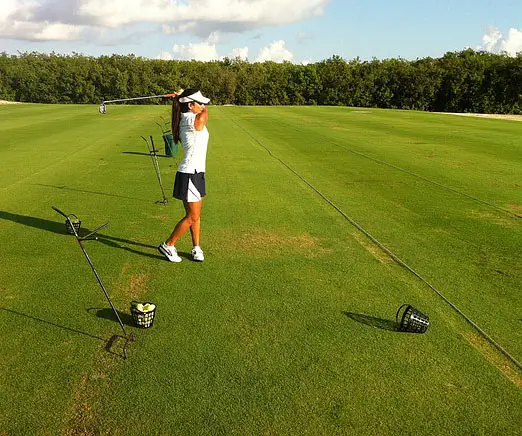
Try to take a shallow divot after the ball. If you are on a mat, try to feel as though you are brushing the mat after impact. You should not be crashing down steeply into the mat or taking huge divots.
A good drill is to make some practice swings without a ball, trying to take a divot (or brushing the mat) after where the ball would be.
Don’t worry if you don’t get it right straight away. Just keep practicing until you can do it. Allow yourself to naturally adjust your swing to be able to make the move. Then, try to remember what that feels like.
Once you can do it without a ball, try replicating it with a ball. Try not to think about hitting the ball, just make a swing and allow the ball to get in the way.
As some pointers, you may find that feeling as though you are hitting a low shot helps. This feeling may help you to achieve some forward shaft lean.
Forward shaft lean (hands ahead of the ball at impact) moves the low point of the swing forward (after the ball) and ensures that your swing is shallow . This should help to avoid the fat shot and make taking a divot after the ball much easier.
You may also find that allowing your weight to shift to your front foot helps. Do not overdo this or you will make a steep swing. But if you are someone that tends to hit off your back foot, this can really help. Just try to finish in balance on your front foot. Pose for the cameras (or people watching)!
As with any golf swing, make sure that you rotate your body through the ball. If you do not turn your body, not only will this cost your distance, it will also rob you of consistency and quality of strike.
Unfortunately, you do not get relief from a divot. If your ball happens to roll into a divot, you will have to play it out!
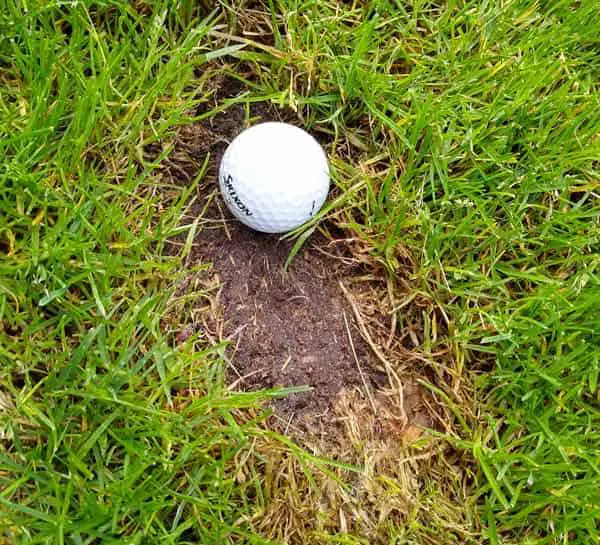
This may sound a bit harsh, and it can be. There’s nothing more frustrating that hitting a good shot in the fairway, only to find your ball in a divot.
However, playing out of one isn’t too difficult. There are just a couple of small adjustments you need to make.
The key to hitting out of a divot is to make a steeper swing. This will ensure that you catch the ball before the turf, making solid contact much more likely.
The easiest way to make a steeper swing is to simply take a shorter club. For example, you should find playing a wedge out of a divot much easier than a 7 iron or a longer club.
However, you may want to hit the ball further than this. In that case, you can play your normal club but play the ball back in your stance and try to take a big divot.
Thats right, you fight a divot with a divot!
Typically it is also a good idea to make a shorter swing, which should help you to achieve a steeper approach. This should prevent your club from snagging on the divot in front of the ball and make solid contact much more likely.
Be aware that the ball will typically fly lower and will sometimes come out thin. Distance control can be very difficult.
I would not recommend playing over water from a divot, unless you are very confident. But once you learn how to play it, it’s not as difficult as you think.
We know that taking divots helps pro golfers but there is a way to do it wrong. In fact, there are a few ways.
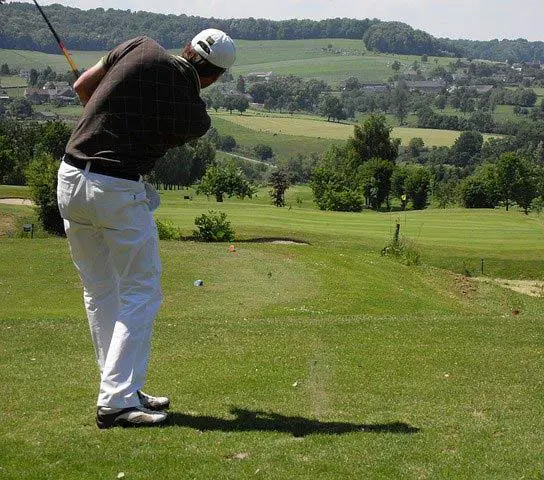
Here are a few of the main ways not to take a divot:
Doing any of these defeats the object of taking a divot. Instead of giving yourself more room for error, you are giving yourself less.
Combine any of these errors are the results could be disasterous!
Huge divots are caused by a steep angle of attack. This is where the clubhead is coming into impact from high above the ground and being driven down into the ground at a steep angle.

There are a few pro golfers that have done this over the years so you can still play good shots with it. However, you are massively reducing the room for error. Hitting the ball fat or this becomes much more likely when the clubhead is moving so steeply into the ball.
Large divots are more likely with short irons and wedges since the club is shorter and has a steeper lie angle. So larger divots are to be expected with these clubs but it is important not to overdo it or you will struggle to achieve a consistent strike.
Hitting the ground before the ball is known as a fat shot. In general, a fat shot is worse than a thin shot so it should be avoided at all costs.
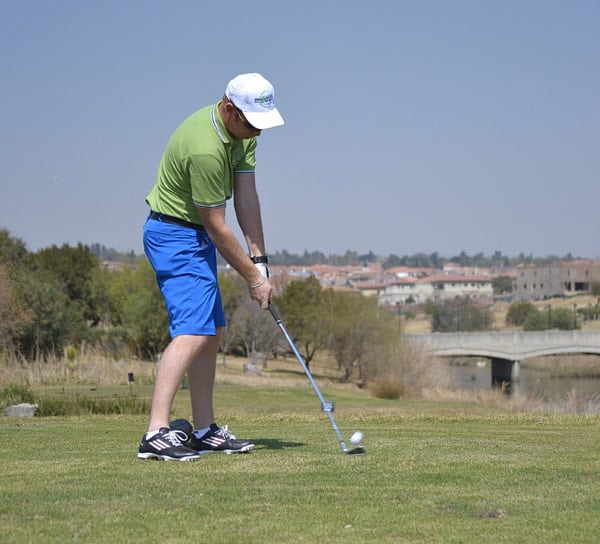
Contact with the ground before the ball will almost always result in a poor strike. At best it could lead to slight loss of distance, at worst it could lead to complete inconsistency. It is impossible to know how far a fat shot will travel.
This is something that very amateurs struglle with but some pros do occasionally. Taking a divot too far after the ball leads to thin strikes.
Whilst a thin strike is generally not as bad as a fat strike, it can still lead to large inconsistencies. A thin strike can travel shorter or further than intended. This can make distance control very difficult.
Some golfers become afraid to take a divot and this can cause huge issues with their iron and wedge game. This usually occurs due to fear of injury or fear of the fat shot.
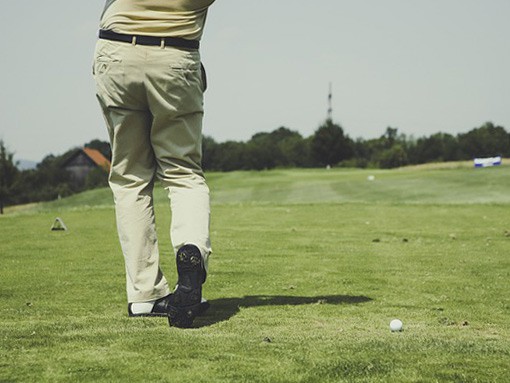
Being afraid to take a divot can be a mental barrier to hitting great shots. You may find it difficult to commit to the shot fully. In general, taking a divot is nothing to worry about.
Fear of injury is not usually justified. Very few golfers have experienced any injuries as a result of taking a divot. As well as the turf absorbing shock, so does the clubhead, the shaft, and the rubber grip on the end of the club.
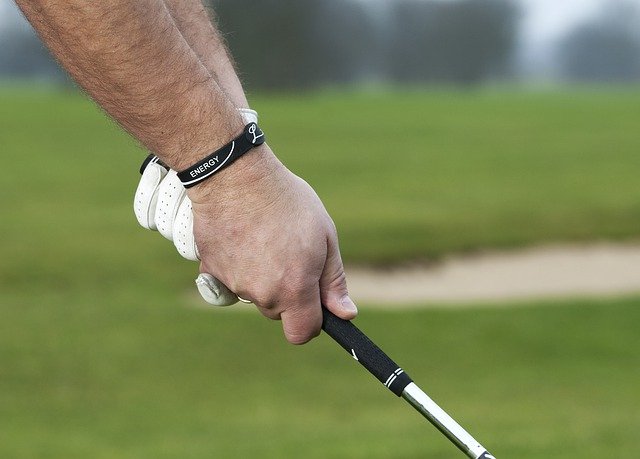
If you are playing on soft ground, the club will go through the turf like a knife through butter. If you are playing on firm ground then it could be more of an issue but only if you are very steep. The goal should be to take a very thin divot not a huge one.
Unless you have any specific injuries (such as a wrist injury) that could be affected then I wouldn’t worry about it.
A fat shot can occur when taking a divot and obviously this should be avoided. But the fat generally only happens when the swing is too steep or the golfer plays off their back foot.
It’s easy to get into all the technical aspects and get lost in the detail. But there’s no need because avoiding the fat is quite simple, really.
Rather than getting obsessed with swing thoughts, just practice until you can take a divot after the ball. Practicing on a grass griving range is ideal, if possible. If not, find some grass that you can dig up somewhere, preferably not the front lawn!
If you are practicing on a driving range mat, just ensure that you hit the mat after making contact with the ball. Also make sure that you aren’t hitting the mat hard, this would be an ndication that your swing is too steep into impact.
In the end, I think the vast majority of golfers would benefit from taking on a divot on most shots. If you like, you can take a divot with every club in your bag except the Driver and Putter.
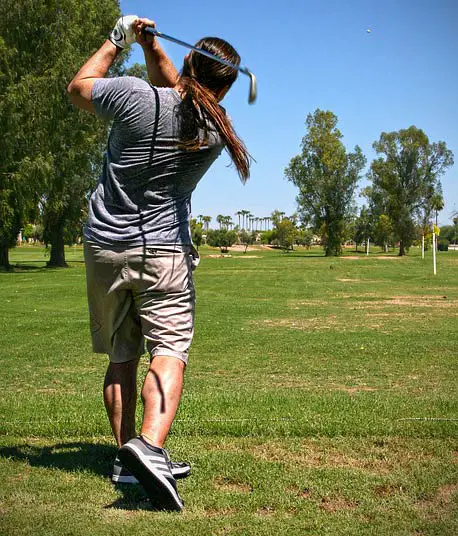
I would recommmend experimenting and doing whatever works for you. Taking a divot with shorter irons and wedges is highly recommended. With longer clubs though it’s mainly down to personal preference.
Good luck and have fun hitting some balls!

I’m Tom Rothwell and I’m a 3 handicaper that's obsessed with golf. You can often find me hitting balls on a driving range somewhere!
I'm on a journey to learn as much as possible about the great game. I've made Clean Strike Golf to share everything I discover along the way.